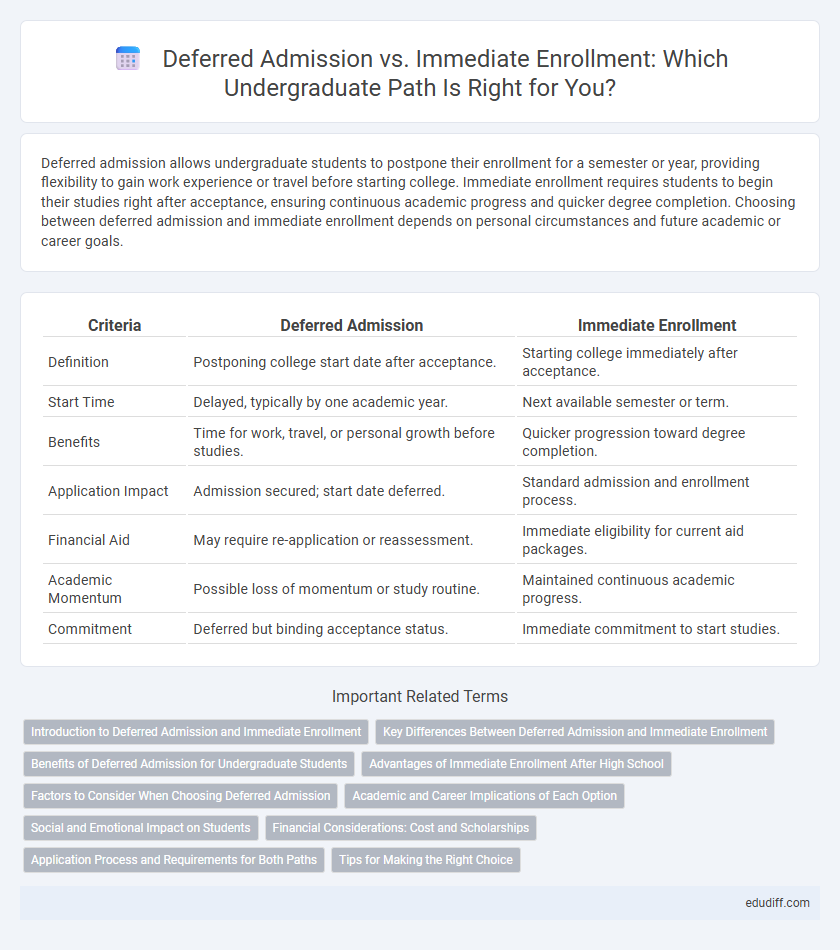Deferred admission allows undergraduate students to postpone their enrollment for a semester or year, providing flexibility to gain work experience or travel before starting college. Immediate enrollment requires students to begin their studies right after acceptance, ensuring continuous academic progress and quicker degree completion. Choosing between deferred admission and immediate enrollment depends on personal circumstances and future academic or career goals.
Table of Comparison
| Criteria | Deferred Admission | Immediate Enrollment |
|---|---|---|
| Definition | Postponing college start date after acceptance. | Starting college immediately after acceptance. |
| Start Time | Delayed, typically by one academic year. | Next available semester or term. |
| Benefits | Time for work, travel, or personal growth before studies. | Quicker progression toward degree completion. |
| Application Impact | Admission secured; start date deferred. | Standard admission and enrollment process. |
| Financial Aid | May require re-application or reassessment. | Immediate eligibility for current aid packages. |
| Academic Momentum | Possible loss of momentum or study routine. | Maintained continuous academic progress. |
| Commitment | Deferred but binding acceptance status. | Immediate commitment to start studies. |
Introduction to Deferred Admission and Immediate Enrollment
Deferred admission allows undergraduate students to secure a place at a university while postponing their enrollment for a semester or a year, providing flexibility to pursue other interests or commitments before starting their studies. Immediate enrollment requires students to begin their undergraduate program in the semester following their acceptance, ensuring continuous academic progress and earlier degree completion. The choice between deferred admission and immediate enrollment significantly impacts a student's educational timeline, personal development, and preparedness for college life.
Key Differences Between Deferred Admission and Immediate Enrollment
Deferred admission allows undergraduate students to secure a spot at a university while postponing their enrollment, typically for a year, enabling opportunities such as work experience or travel before starting. Immediate enrollment requires students to begin their studies in the semester following acceptance, ensuring continuous academic progression and quicker degree completion. Key differences include timing of entry, flexibility for personal development, and impact on career planning and academic momentum.
Benefits of Deferred Admission for Undergraduate Students
Deferred admission offers undergraduate students the opportunity to gain valuable work experience, travel, or strengthen their academic profile before starting college. This option can enhance personal growth, clarify career goals, and improve readiness for rigorous academic challenges. Students who choose deferred admission often return with increased motivation and a clearer sense of purpose, which can lead to higher academic success.
Advantages of Immediate Enrollment After High School
Immediate enrollment after high school accelerates access to college-level resources, fostering early academic and social development. Students benefit from uninterrupted momentum in their studies, which can lead to higher retention and graduation rates. Engaging directly with campus opportunities, such as internships and networking, supports timely career readiness and skill acquisition.
Factors to Consider When Choosing Deferred Admission
When choosing deferred admission, students should evaluate their readiness for academic challenges, financial stability, and personal growth opportunities during the gap period. Consideration of how deferral impacts scholarship eligibility, course availability, and campus housing is crucial for a smooth transition. Prioritizing mental health and career planning during the deferral period can enhance overall undergraduate success.
Academic and Career Implications of Each Option
Choosing deferred admission allows students to gain real-world experience, explore career interests, and enhance their resumes before starting their undergraduate studies, which can lead to greater academic focus and motivation upon enrollment. Immediate enrollment, however, fosters continuous academic momentum and quicker degree completion, which benefits those aiming to enter the workforce or graduate studies promptly. Balancing these options depends on individual career goals and the value placed on immediate academic progression versus experiential learning and personal development.
Social and Emotional Impact on Students
Deferred admission allows students time to mature emotionally and develop social skills before starting university, reducing stress and improving mental health outcomes. Immediate enrollment promotes continuous academic momentum but may increase anxiety and social adjustment challenges due to sudden transitions. Balancing readiness with academic goals is crucial for optimizing students' social well-being and emotional resilience.
Financial Considerations: Cost and Scholarships
Deferred admission can impact the timing and availability of scholarships, as some financial aid offers may expire or be re-evaluated upon deferral. Immediate enrollment allows students to access tuition payment plans, campus employment opportunities, and scholarship funds without delay. Evaluating cost differences between deferring and enrolling immediately is essential to maximize financial support and minimize out-of-pocket expenses during undergraduate studies.
Application Process and Requirements for Both Paths
Deferred admission requires submission of a formal request along with the original application by the university's deadline, often including a justification letter and proof of intent to enroll later. Immediate enrollment demands completion of all standard application materials--transcripts, recommendation letters, and standardized test scores--by the posted deadline, enabling students to start their studies in the upcoming semester. Both pathways necessitate adherence to university-specific guidelines, but deferred admission may involve additional documentation or fees to secure a future enrollment spot.
Tips for Making the Right Choice
Consider personal readiness and academic goals when choosing between deferred admission and immediate enrollment in undergraduate studies. Evaluate factors like financial stability, mental health, career planning, and opportunities for internships or work experience during a gap year. Consult academic advisors and review university policies on deferral to ensure the decision aligns with long-term educational success and personal development.
Deferred Admission vs Immediate Enrollment Infographic

 edudiff.com
edudiff.com